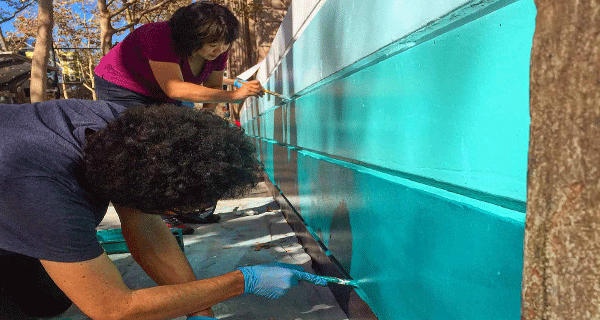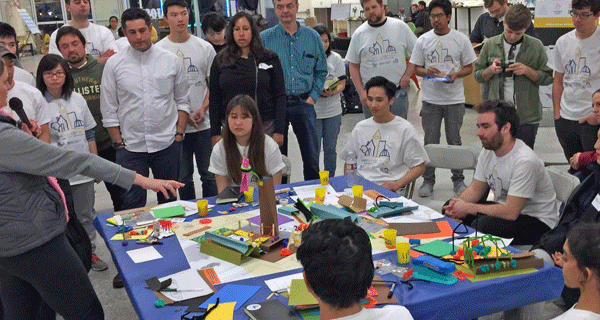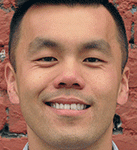24 Apr Work in progress: From Neglected Alley to ‘Open Gallery’ in Downtown San Jose
By Jason Su, Emerging City Champions Fellow, 2016
This is a story of how a fellowship launched a project that engaged people in improving an alley in downtown San Jose, California.
Building more successful cities
Last June, I landed in Toronto, visiting our neighbor to the north for the first time. I was part of the first class of “K880 Emerging City Champions,” a fellowship program led by 8 80 Cities, a Canada-based nonprofit dedicated to transforming cities, and supported by the Knight Foundation. Through a competitive application process, 8 80 Cities and the Knight Foundation selected 25 young civic innovators to participate in the program. Each champion received $5,000 in funding, professional mentorship, and an invitation to attend the workshop in Toronto to support them in implementing high-impact urban projects that will strengthen mobility, improve public spaces, and enhance civic engagement in their cities.
The four-day program in Toronto facilitated a series of learning opportunities for civic innovators, urbanists, and city builders from communities where the Knight brothers once owned newspapers: Akron, Ohio; Charlotte, N.C.; Detroit; Macon, Ga.; Miami; San Jose, Calif.; St. Paul, Minn, and others. The champions came from diverse backgrounds: education, community development, youth leadership, design, advocacy, planning, and more.
I have always considered planning to be closely aligned with placemaking and civic engagement, but participating in this fellowship highlighted for me where they differ, and where they complement the overall goal of promoting good city building.
The four-day event touched on placemaking, storytelling, equitable access, and other concepts essential to creating opportunities for engagement and building cities for people. The fellows left the program with networks, friendships, and a renewed sense that change, if desired, needs to come “from you.”
My focus
I work primarily in downtown San Jose. As the San Jose Downtown Association’s street life manager, I implement a number of capital and public art projects to improve downtown’s visual vibrancy and pedestrian experience while maintaining the existing urban tree canopy and landscaping. As in many cities across the nation, downtown San Jose has places you showcase to others, and places where additional work is needed. One of the latter is downtown San Jose’s Fountain Alley.
Fountain Alley lies in the heart of downtown’s historic district. It runs parallel to and just south of E. Santa Clara St. between S. 1st St. and S. 2nd St. Surrounded by light rail stations, restaurants, nightlife, homes, and downtown’s most iconic building — the Bank of America tower — the alley has the basic ingredients for a great place. In addition, the east end of Fountain Alley is a potential Bay Area Rapid Transit station entrance to downtown San Jose, putting pressure on the alley to serve as downtown’s gateway to the BART network. But the alley is underutilized and plagued by poor public perception, drug use, and other antisocial behavior.
‘Open Gallery Alley’
Art, activation, and community collaboration can bring new life to a neglected but cherished place. I presented the idea of “Open Gallery Alley” — a pop-up art gallery in Fountain Alley — to the fellowship, and came back with “risk capital” funding and strategies on how to implement change inclusively and recruit community allies to support the work. “Open Gallery Alley” aims to turn Fountain Alley into a community asset through a pop-up gallery showcasing local artists and talent.

Children paint on a community mural hosted by the Exhibition District during the pop-up art gallery. Photo: Jason Su
The four-day conference was refreshing in its characterization of “community change agent.” While labels like planners, architects, and advocates imbue a level of expertise and trust, they also create a subconscious barrier to entry. Having a planning background while “placemaking” showed me how truly difficult public space activation can be, but how immediate and necessary change is for the affected communities.

Local residents repaint walls and planters in Fountain Alley. Photo: Ellina Yin
Back home, and after two community meetings, a design charrette, and an alleyway cleanup, we were ready to prototype Fountain Alley. Our first event was held on November 11, Veterans Day, and November 12, a Saturday, in 2016. We had music, performances, games, artists live painting, and a community “mural paint” hosted by Exhibition District, a local artists collaborative. We borrowed crates and turf from San Jose’s Tech Museum, and brought out Adirondack chairs to bring ‘green’ lounging to the space. Over the two days, between 1,200 and 1,500 people walked through or paused in the space. The reception was positive, and led to inquiries about future placemaking and investment efforts — and to conversations about larger issues, such as how to increase retail and promote safety, and how to make a space usable for everyone.
A second phase
The project’s second iteration is a collaboration with San Jose State University’s industrial design studio and CommUniverCity, a collaborative launched in 2005 as a way to engage San Jose State University students in solving real-life neighborhood issues.

Together with the downtown community, San Jose State “Design for All” students, http://bit.ly/2o2vOVd, host a co-design workshop for a reimagined alleyway. Photo: Jason Su
On March 1, 2017, a co-design workshop of 50 students and community members was hosted at Local Color, a former Ross store repurposed into an affordable art studio. The students broke into teams based on four “street life” concepts: parklets and stages; planters, wind chimes, and birdhouses; seating; and lighting and mobile solar hubs. After feedback from the community, the students will be creating cardboard mock-ups to be displayed on March 22 (the news deadline for this article). A final functional prototype of the concept is planned for early May.
By the end of the fellowship term in June 2017, we will have a year’s worth of community outreach, design charettes, prototype interventions, and a structure for “alleyway activation.”
Takeaways
It will take more than a few events and meetings to truly transform Fountain Alley. Still, in one year, local perception of the space has improved, and general community engagement has increased, leading to others projecting what they want to see in the alley. Project for Public Spaces, founded in 1975 to expand on the work of William (Holly) Whyte, author of The Social Life of Small Urban Spaces, has defined placemaking as a process. By opening the alleyway as a platform for all to influence, the alley can reimagine itself under public stewardship.
Needing to see the Fountain Alley project from start to finish — to find funding, meet with community members, design flyers, load and unload equipment, and do it all over again — gave me an extra level of appreciation for placemaking. Planning is essential to good city building, but it needs and relies on related activities like placemaking, advocacy, and economics for its success. As a planner, I feel fortunate to be part of this fellowship.

Jason Su is the Street Life Manager for the San Jose Downtown Association. His degrees include master of urban planning, San Jose State University; BA in economics and sociology, UC Irvine; and certificate in landscape architecture, UC Berkeley Extension. You can reach him at jsu@sjdowntown.com, or visit the Fountain Alley website at www.opengalleryalley.com



